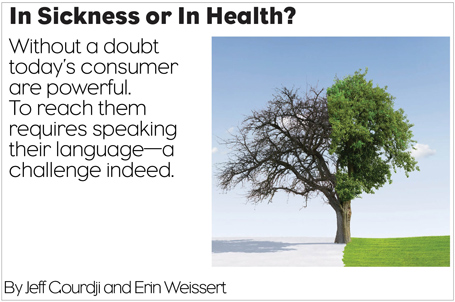While U.S. healthcare is still very much a work in progress, with new economic and regulatory pressures reshaping virtually every business model, one diagnosis remains the same: Consumers are powerful. Winning them over requires speaking their language, and that’s a real challenge. On one side, health systems still operate from their lexicon of sickness—they run hospitals, medical centers and clinics. But when consumers talk about health, they do so more broadly, thinking about diet, fitness and other wellness offerings.
And it isn’t just consumers who are forcing these larger definitions. The universe of regulators and insurers are increasingly linking reimbursement to an organization’s ability to keep people healthy. Metrics like “How many of your patients quit smoking last year?” and “How much weight have they lost?” are taking on a new importance, and many in the industry are still flummoxed as they move away from old fee-for-service models.
That’s led to an era of experimentation, with providers dabbling in a whole lexicon that seems invented just to confuse. Among themselves, they tout value-based care, for instance, which a consumer might overhear as meaning “more for my money,” instead of its true (and less folksy) definition, which is “patient outcomes divided by total cost per patient over time1.” Or they refer to themselves as a medical home, industry-speak for a patient-centered philosophy that makes sure people and providers are on the same page. But when that terminology strays into office conversations or consumer-facing brochures, it just sounds like a scary place to send old Aunt Sally.
What’s in A Name?
The most conspicuous evidence of this experimentation is what healthcare systems call themselves, with dozens of systems undergoing rebranding efforts. Some—such as Duke Medicine, Northwestern Medicine, and the University of Maryland Medical Center—are going down the path toward more illness-focused nomenclature. These names, the thinking goes, play to an organizations’ scientific roots. Others have chosen to pivot toward health-focused words instead, hoping to connect with people around broader ideas about health and wellness. Children’s Medical Center Dallas has become Children’s Health System of Texas2. The Mount Sinai Medical Center is now the Mount Sinai Health System. Novant Health, a Prophet client, has renamed all its hospitals and medical centers. There’s even a subset of health systems doing a little of both, heightening their university affiliations, to emphasize their commitment to learning and scientific advances, but still stepping away from the term medicine. These include Indiana University Health, University of Wisconsin Health, and University of Florida Health.
Why does it make sense for one system to invoke names that suggest white coats and stethoscopes and another company to emphasize health and wellness? While much depends on the wide range of stakeholders—hard-to-hire doctors, nurses and other employees, community leaders, and perhaps even medical students—we believe consumers will be the ultimate arbiters of which systems are successful and which are not. And even if people aren’t consciously aware of how the name affects them, it’s the first opportunity organizations have to tell potential customers what they stand for.
It’s All About Values
But providers need to be mindful that consumers’ health dialect isn’t just about words—it’s about values. Seeing health from their perspective requires going beyond rhetoric to fully exploring people’s ideas and feelings about health and wellness. In our work for a large wellness products retailer, when we asked customers to rank key dimensions of health and wellness in general they were quick to name nutrition as most important, followed by exercise. But regular healthcare visits? Those came in a distant third. (Overall, 77% felt nutrition had the top influence on health and wellness, and 60% felt that exercise was most important. Only 45% thought routine healthcare mattered most.4) It’s not that they don’t trust their doctor’s advice in these areas. In fact, about 50% say that they value their doctor’s opinion more than other sources of information, including what they learn online or from friends and family. It’s just that in their mind, health and wellness have more to do with daily walks and nutrition choices than any visit with their doctor.
That’s a conundrum. But it also presents tremendous opportunities for health systems to redefine not only how they frame their offering, but also their very purpose, finding new ways to support and delight consumers in their efforts to manage and protect their health. This focus—on the consumer’s view of health and wellness but not the organization’s—can be the lens healthcare systems use to reimagine everything from the name on the door, new offerings, patient acquisition and retention efforts—even recruiting physicians.
What’s missing is bigger thinking about how to tap into consumers’ holistic approach to health. Their questions about diets, workouts, and the way they manage stress aren’t just important to them—they’re essential to the healthcare organization’s success. In research for a client, a large regional healthcare system, we found that a doctor who “provides recommendations on nutrition, exercise and wellness” is one of the top three drivers of whether or not people recommend the provider. And it was almost as important as “has the best doctors or hospitals.”
Shifting to Consumer-focused Care
So if health systems now have both permission from consumers and incentives from insurers to think about health differently, why are they struggling to move from sick care to healthy care? Part of it is time. The industry is still reacting to the Affordable Care Act. And the average primary care physician (PCP) only has 20.3 minutes with each appointment4, which doesn’t leave much time for health and wellness coaching—even if they knew how to do it. There’s even another barrier, beyond time and know-how: PCPs don’t get reimbursed for coaching under traditional models, although that’s changing under value-based care.
But it’s coming fast. Organizations show proven results—for example, such as Kaiser Permanente’s “Exercise as a vital sign” program. FVRx, or the Fruit and Vegetable Prescription Program used in some New York area hospitals, has also made a measurable difference in health5. (Not only did 96% of participating families eat more produce after getting these prescriptions, 90% shopped at local farmers’ markets and 70% understood more about the impact of diet on health. Best of all, 40% of the participating children lowered their BMI.) Health and wellness options aren’t just driving revenues. They are creating better outcomes, and that means people will soon demand them.
So while it’s more important than ever to choose words wisely, the real lesson for healthcare companies is understanding why people react so differently to these words, whether you’re offering medical hospitals or wellness clinics. Are you making decisions based on insights? On an intimate appreciation of consumers’ needs, concerns and aspirations? Aligning the organization’s strategy around those needs—then choosing the language, products and services that best suits them—is the only way to remain relevant to today’s healthcare consumer. That won’t just drive financial success. It will earn peoples’ love and loyalty.
Sidebar: How Markets Can Create Better Patient Relationships
Only 42% of the public views pharmaceutical companies favorably, making them less popular than banks (58%) and the airline industry (55%), according to a recent survey conducted by the Kaiser Family Foundation. This perception is most likely influenced by a number of factors (for example, the same survey found that 72% of the public thinks the cost of prescription drugs is unreasonable).
The pharmaceutical industry can begin to combat this negativity by focusing more on consumers’ holistic health needs, rather than narrowly providing treatment for specific conditions. While the U.S. healthcare system is still very much a work in progress, new economic and regulatory pressures are reshaping virtually every sector’s business model. One theme is consistent: Consumers are powerful and their expectations of brand experiences are only increasing. With the rising trend toward consumerism, it is critical for pharmaceutical marketers to find a way to connect with consumers in a way that matters to them.
A new model for consumer engagement can help pharmaceutical companies move from “the sale of medicine” to “the sale of a healthier life” by creating and sharing content with consumers. One example: Eli Lilly and Disney’s strategic partnership to provide education to families with children who have diabetes. This approach must include more than dialogue with consumers. It should also offer a platform for people with similar conditions to engage with each other about symptoms, treatment options, their overall health and ways the condition can affect their overall lives. Doing so will not only help consumers manage their health and encourage adherence to prescribed medications, it will also create an ongoing feedback loop that can facilitate innovation and relevance for the brand. This relevance, in turn, will drive financial success for the company, and earn trust and loyalty from consumers.
Resources:
1. http://www.iom.edu/Global/Perspectives/2012/FirstStep.aspx.
3. Prophet retail deck.
5. http://well.blogs.nytimes.com/2014/12/01/prescribing-vegetables-not-pills/?_r.







